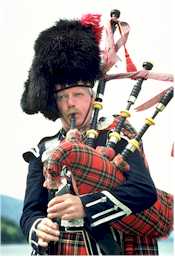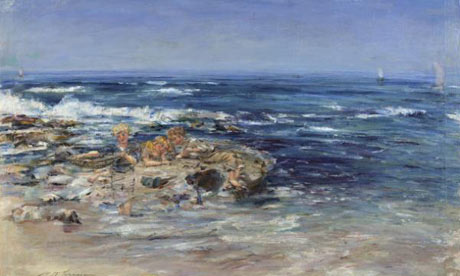The instrument that most highlights of the land is the great Scottish bagpipes, wind instrument fed continuously by a reservoir of air in a bag and also the bagpipes are one of the most famous icons of Scotland, and the piping tradition is still going strong in the 21st century.
As for art with the beginning of the new century the Scottish art is booming. The four schools of fine arts in the country continue to promote experimentation and innovation among its students in a variety of means of expression.
That's why I show you how founded Scottish music and the evolution that has taken until now letting us see its rich culture with the birth of Scotland makes more 4000 years that followed the construction of monuments such as the extraordinary megalithic monument Calanais Stones on the islands of the West and the impressive Ring of Brodgar in Orkney Islands witnessed the passage of the Romans and the arrival of the same Scots from Ireland. In that period, same Scotland was forging is an identity, as evidence the fact that Kenneth MacAlpin seven as King of Scots, which would mark the beginning of the Scottish Kingdom covering the period between the middle of the 9th century until the end of the 13th.
That's why I show you how founded Scottish music and the evolution that has taken until now letting us see its rich culture with the birth of Scotland makes more 4000 years that followed the construction of monuments such as the extraordinary megalithic monument Calanais Stones on the islands of the West and the impressive Ring of Brodgar in Orkney Islands witnessed the passage of the Romans and the arrival of the same Scots from Ireland. In that period, same Scotland was forging is an identity, as evidence the fact that Kenneth MacAlpin seven as King of Scots, which would mark the beginning of the Scottish Kingdom covering the period between the middle of the 9th century until the end of the 13th.
If music is the food of love, then the Scots are true romantics with a wide and varied diet! Whatever the style - whether the orchestral swell of James McMillan's classical work, the lyrical fluency of Dougie McLean's ballads, Blazing Fiddles' irresistably foot-tapping reels and jigs, or the singalong rockabilly of The Fratellis - music is a vital part of the nation's cultural life.
It's celebrated across the country and throughout the year in large-scale gatherings like the Gaelic Mod, T in the Park or the Edinburgh International Festival, busy concerts at the Usher Hall or the Royal Concert Hall or more intimately in pubs, clubs and howffs in every town and village.
The instrument that most highlights of this land is the Great Scottish bagpipe wind instrument fed continuously by a reservoir of air in a bag.
There are numerous gaiteras bands, consisting of bagpipes and various types of drums, showing Scottish music styles while creating new ones, has spread around the world.
Other instruments also traditional Scottish, although less characteristic are the harp, violin and accordion, and especially
these last two are very prominent in Scottish country dance bands.
Currently, there are many successful bands of Scotland and its artists stand out in different styles.
The first appearance of the bagpipe is in Scotland in the late 1400s while it could have been introduced in Scotland from the 6th century.
The name of the "great Bagpipe" was associated with families and pipes hereditary in the professional Pipers to various heads of clans; pipes were later adopted for use in other locations, including military marching.
Traditional music
Traditional Scottish music isn't only about bagpipes and fiddles. Rather, it encompasses a range of styles and forms that emerged from different strands of the country's historical, geographical and social heritage.
Celtic folk
As in much of northern Europe, the story of Scotland’s roots scene begins amid the 'folk revival' of the 1960s, a time when folk song and traditional music engaged people who did not have strong family links with an ongoing tradition.
For many in Scotland, traditional music had skipped a generation and they had to make a conscious effort to learn about it. At first, the main influences were largely American - skiffle music and artists like Pete Seeger - but soon people started to look to their own traditions, taking inspiration from the Gaelic songs of Cathy-Ann McPhee, then still current in rural outposts, or the old travelling singers like the Stewarts of Blairgowrie, Isla Cameron, Lizzie Higgins, and the greatest of them all, Lizzie’s mother, Jeannie Robertson.
Folk music
Folk music takes many forms in a broad musical tradition, although the dividing lines are not rigid, and many artists work across the boundaries. Culturally, there is a split between the Gaelic tradition and the Scots tradition.
The oldest forms of music in Scotland are theorized to be Gaelic singing and harp playing. Although much of the harp tradition was lost through extinction, the harp is being revived by contemporary players. Later, the Great Highland Bagpipe appeared on the scene. The original music of the bagpipe is called Piobaireachd, this is the classical music of the bagpipe. 'piobaireachd' means 'big music' in Gaelic. Piobaireachd consists of a theme melody called the 'ground' followed by variations. Later, the style of 'light music,' including marches, strathspeys, reels, jigs, and hornpipes, became more popular. The British army adopted piping and spread the idea of pipe bands throughout the British Empire. Presently, piping is closely tied to band and individual competitions, although pipers are also experimenting with new possibilities for the instrument. Other forms of bagpipes also exist in the Scottish tradition; they are detailed in the piping section below.
Vocal music is also popular in the Scottish musical tradition. There are ballads and laments, generally sung by a lone singer with backing, or played on traditional instruments such as harp, fiddle, accordion or bagpipes. There are many traditional folk songs, which are generally melodic, haunting or rousing. These are often very specific to certain regions, and are performed today by a burgeoning variety of folk groups.
Art
 |
As we begin a new century, Scottish art is thriving. The country's four art schools continue to initiate experimentation and fresh thinking amongst their graduates across a wide range of media while the major galleries are promoting Scottish art to an unprecedented degree. Major exhibitions provide a welcome platform for almost every aspect of the nation's art history which in turn has ensured that the volatile art market has kept pace with it. Scottish art is thus the focus of greater debate, analysis and public interest than at any time in recent memory
Painting
Scottish painting is closely linked to the English artistic tradition, since many artists worked in London. Some were also great explorers, influenced the different European artistic movements. However, most remain unknown outside its borders. You can admire beautiful collections of Scottish painting in the national galleries in Edinburgh and the art museums in the country's major cities: Aberdeen, Glasgow, Perth, Dundee.
 |
| Alexander Nasmyth |
Landscapes and historical scenes
Alexander Nasmyth (1785-1859), an Assistant to Ramsay, gained renown as a landscaper (Robert Burns, The Windings of the Forth, Distant Views of Stirling).The Falls of the Clyde, of neoclassical Jacob More, is a good example of idealized reproduction of nature. Gavin Hamilton (1723-1798) painted large historical compositions (illustrations of the Iliad of Homer: The Abdication of Mary, Queen of the Scots) and gained fame in Rome. In century 19th there was a revival in interest in the Scottish landscape through the novels of Sir Walter Scott, and Horatio McCullough (1805-1867) was held by their landscapes in the Scottish Highlands. The artistic talent of David Wilkie (1785-1841) is evident in his popular scenes costumbrismo (Pitlessie Fair, Distraining for Rent the) or in his portraits (george IV), which shows the influence of Raeburn. The gentle Shepherd illustrates the pastoral poem of Ramsay.
 |
| David Wilkie |
The foundation of the Scottish Academy in 1836 allowed the talent of the country to flourish. William McTaggart (1835-1910) developed a very personal style as opposed to Victorian conventions: bold handling of the brush, light, richness of color effects; This is reflected in its spectacular marine (The Store, Dawn at is, the Fishers'Landing) and landscapes (Corn in the Ear, Spring, Rosslyn Castle: Autumn).
During the second half of the 19th century wealthy collectors and art dealers promoted the artistic activity of Glasgow. The works of the Glasgow School leave to see the influence of Impressionism and other European artistic movements, such as the school of the Hague.There are many exceptional artists coming out of the school of fine arts of Glasgow: r. Colquhoun (1914-1962), in whose works titled The Dublin and Figures in a Farmyard reflected the influence of cubism, and r. MacBryde (1913-1966), author of The Backgammon pleasure and Fish on a Pedestal Table (original combination of unusual objects). Both Anne Redpath (1895-1973) - who painted beautiful landscapes (Village Temple) and budgones - belonged to the school of fine arts in Edinburgh.
| Anne Redpath |
 he New Image Group, from Glasgow, had printed his brilliant mark on the contemporary scene. The influence exerted by Fernand Léger and Mexican muralists is evident in the emphasis on the human being and the brutal force of the great compositions of Ken Currie (1960), as evidenced by his mural work The Glasgow Triptych. Get Howson (1958) also deals with social realism, but in a more poetic way. The works of Adrian Wiszniewsky (1958) give sample of an active imagination, while Stephan Campbell (1953) raises the enigmas of natural philosophy emphasizing the gesture and the metamorphosis.
he New Image Group, from Glasgow, had printed his brilliant mark on the contemporary scene. The influence exerted by Fernand Léger and Mexican muralists is evident in the emphasis on the human being and the brutal force of the great compositions of Ken Currie (1960), as evidenced by his mural work The Glasgow Triptych. Get Howson (1958) also deals with social realism, but in a more poetic way. The works of Adrian Wiszniewsky (1958) give sample of an active imagination, while Stephan Campbell (1953) raises the enigmas of natural philosophy emphasizing the gesture and the metamorphosis. To finish this essayis one of the features that are more internationally known Scotland is its traditional music, which has been kept alive throughout the 20th century, when many traditional forms worldwide lost popularity because of pop music.
Despite all the changes of the population in Scotland, they have to developed sense of music imported from the rest of Europe and the United States, and his has led to the music of Scotland has kept many of its traditional aspects and that in fact this has influenced many forms of music. It tends to associate Scottish folk music with bagpipes.
Today Scotland currently hosts every year hundreds of national and international artists, in addition to housing some of most important festivals of the musical such as Dunbar Traditional Music Festival, panorama The Lammermuir Festival, Denholm Folk Festival and Dundee Jazz Festival.
I can say that art especially in the period of the Scotisah Illustration was I would say great cultural development for Scotland. Its artist and architecs were consciously cosmopolitan had an important role on the international scene.
In addition, painters such as Allan Ramsay, Gavin Hamilton, Henry Raeburn and David Allan were artists of great European Importance.
References
Escocia. (2002-2011). Blog-escocia, http://blog-escocia.com/cultura-de-escocia/musica-en-escocia
Escocia. (2002-2011). Blog-escocia, http://blog-escocia.com/cultura-de-escocia/arte-en-escocia
Scotland, (2002-2011). Visitscotland, http://www.visitscotland.com/guide/scotland-factfile/arts-culture/music/







